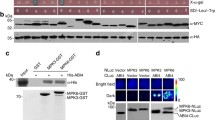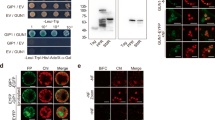Abstract
Chloroplast–nucleus communication takes place via processes called anterograde and retrograde signaling pathways. Discovery of the retrograde signaling pathways from the chloroplasts to the nucleus also raised an intriguing proposition that chloroplasts may serve as environmental sensors since multitudes of environmental factors disturb chloroplastic homeostasis. Certain chloroplastic perturbations, mostly impairing transcription/translation, are coupled to the repression of photosynthesis-associated nuclear genes (PhANGs), thus finely coordinating photosynthetic and chloroplastic homeostasis. The unbiased forward genetic screen in Arabidopsis leads to the identification of six independent loci called GENOMES UNCOUPLED (GUN), whose inactivation was found to de-repress the expression of PhANGs under certain conditions promoting retrograde signaling. Of the six GUNs, five encode proteins associated with tetrapyrrole biosynthesis and one, namely GUN1, encodes a member of the pentatricopeptide repeat protein family. Despite the fact that GUN1 plays a role as a central signaling mediator for retrograde communication, the molecular details of GUN1 protein still remain to be elucidated. Here, we recapitulate our current understanding of the GUN1-mediated retrograde signaling pathway and propose a possible mode of action of GUN1 in the chloroplasts together with different aspects of GUN1 protein activity that deserve further investigation.
Similar content being viewed by others
References
Barkan A, Small I (2014) Pentatricopeptide repeat proteins in plants. Annu Rev Plant Biol 65:415–442
Bradbeer JW, Atkinson YE, Borner T, Hagemann R (1979) Cytoplasmic synthesis of plastid polypeptides may be controlled by plastid-synthesized RNA. Nature 279:816–817
Brunkard JO, Burch-Smith TM (2018) Ties that bind: the integration of plastid signalling pathways in plant cell metabolism. Essays Biochem 62:95–107
Chan KX, Phua SY, Crisp P, McQuinn R, Pogson BJ (2016) Learning the languages of the chloroplast: retrograde signaling and beyond. Annu Rev Plant Biol 67:25–53
Colombo M, Tadini L, Peracchio C, Ferrari R, Pesaresi P (2016) GUN1, a jack-of-all-trades in chloroplast protein homeostasis and signaling. Front Plant Sci 7:1427
Cottage A, Mott EK, Kempster JA, Gray JC (2010) The Arabidopsis plastid-signalling mutant gun1 (genomes uncoupled1) shows altered sensitivity to sucrose and abscisic acid and alterations in early seedling development. J Exp Bot 61:3773–3786
de Souza A, Wang JZ, Dehesh K (2017) Retrograde signals: integrators of interorganellar communication and orchestrators of plant development. Annu Rev Plant Biol 68:85–108
Feng PQ, Guo HL, Chi W, Chai X, Sun XW, Xu XM, Ma JF, Rochaix JD, Leister D, Wang HY, Lu CM, Zhang LX (2016) Chloroplast retrograde signal regulates flowering. Proc Natl Acad Sci USA 113:10708–10713
Gray JC, Sullivan JA, Wang JH, Jerome CA, MacLean D (2003) Coordination of plastid and nuclear gene expression. Philos Trans R Soc Lond B Biol Sci 358:135–144
Hernandez-Verdeja T, Strand A (2018) Retrograde signals navigate the path to chloroplast development. Plant Physiol 176:967–976
Kacprzak SM, Mochizuki N, Naranjo B, Xu D, Leister D, Kleine T, Okamoto H, Terry MJ (2019) Plastid-to-nucleus retrograde signalling during chloroplast biogenesis does not require ABI4. Plant Physiol 179:18–23
Kleine T, Leister D (2016) Retrograde signaling: organelles go networking. Biochim Biophys Acta (BBA) Bioenerg 1857:1313–1325
Koussevitzky S, Nott A, Mockler TC, Hong F, Sachetto-Martins G, Surpin M, Lim IJ, Mittler R, Chory J (2007) Signals from chloroplasts converge to regulate nuclear gene expression. Science 316:715–719
Llamas E, Pulido P, Rodriguez-Concepcion M (2017) Interference with plastome gene expression and Clp protease activity in Arabidopsis triggers a chloroplast unfolded protein response to restore protein homeostasis. PLoS Genet 13:e1007022
Mochizuki N, Susek R, Chory J (1996) An intracellular signal transduction pathway between the chloroplast and nucleus is involved in de-etiolation. Plant Physiol 112:1465–1469
Page MT, Kacprzak SM, Mochizuki N, Okamoto H, Smith AG, Terry MJ (2017) Seedlings lacking the PTM protein do not show a genomes uncoupled (gun) mutant phenotype. Plant Physiol 174:21–26
Romani I, Tadini L, Rossi F, Masiero S, Pribil M, Jahns P, Kater M, Leister D, Pesaresi P (2012) Versatile roles of Arabidopsis plastid ribosomal proteins in plant growth and development. Plant J 72:922–934
Ruckle ME, Larkin RM (2009) Plastid signals that affect photomorphogenesis in Arabidopsis thaliana are dependent on GENOMES UNCOUPLED 1 and cryptochrome 1. New Phytol 182:367–379
Ruckle ME, DeMarco SM, Larkin RM (2007) Plastid signals remodel light signaling networks and are essential for efficient chloroplast biogenesis in Arabidopsis. Plant Cell 19:3944–3960
Strand A (2004) Plastid-to-nucleus signalling. Curr Opin Plant Biol 7:621–625
Sun XW, Feng PQ, Xu XM, Guo HL, Ma JF, Chi W, Lin RC, Lu CM, Zhang LX (2011) A chloroplast envelope-bound PHD transcription factor mediates chloroplast signals to the nucleus. Nat Commun 2:477
Susek RE, Ausubel FM, Chory J (1993) Signal-transduction mutants of Arabidopsis uncouple nuclear CAB and RBCS gene-expression from chloroplast development. Cell 74:787–799
Tadini L, Pesaresi P, Kleine T, Rossi F, Guljamow A, Sommer F, Muhlhaus T, Schroda M, Masiero S, Pribil M, Rothbart M, Hedtke B, Grimm B, Leister D (2016) GUN1 controls accumulation of the plastid ribosomal protein S1 at the protein level and interacts with proteins involved in plastid protein homeostasis. Plant Physiol 170:1817–1830
Wu GZ, Chalvin C, Hoelscher M, Meyer EH, Wu XN, Bock R (2018) Control of retrograde signaling by rapid turnover of GENOMES UNCOUPLED 1. Plant Physiol 176:2472–2495
Yagi Y, Tachikawa M, Noguchi H, Satoh S, Obokata J, Nakamura T (2013) Pentatricopeptide repeat proteins involved in plant organellar RNA editing. RNA Biol 10:1419–1425
Acknowledgements
We apologize to those authors whose manuscripts are not referred in this short review due to limited space. This study was supported by the 100-Talents Program from the Chinese Academy of Sciences (CAS) and by the National Natural Science Foundation of China (NSFC) Grant 31570264 to C. K.
Author information
Authors and Affiliations
Corresponding author
Ethics declarations
Conflict of interest
We have no conflict of interests to declare.
Additional information
Communicated by Inhwan Hwang.
Publisher’s Note
Springer Nature remains neutral with regard to jurisdictional claims in published maps and institutional affiliations.
Rights and permissions
About this article
Cite this article
Pesaresi, P., Kim, C. Current understanding of GUN1: a key mediator involved in biogenic retrograde signaling. Plant Cell Rep 38, 819–823 (2019). https://doi.org/10.1007/s00299-019-02383-4
Received:
Accepted:
Published:
Issue Date:
DOI: https://doi.org/10.1007/s00299-019-02383-4




